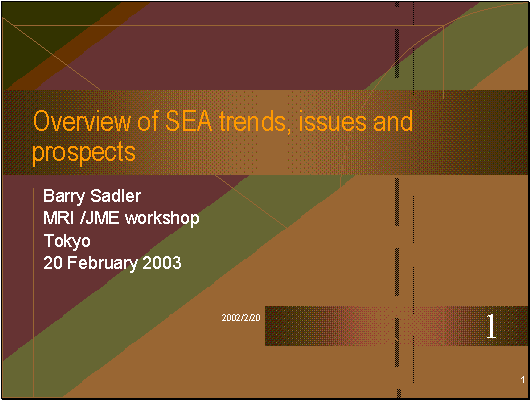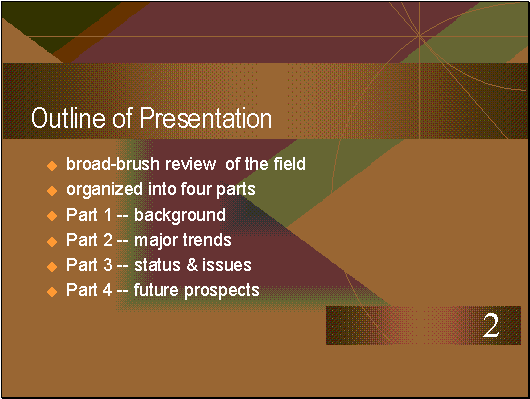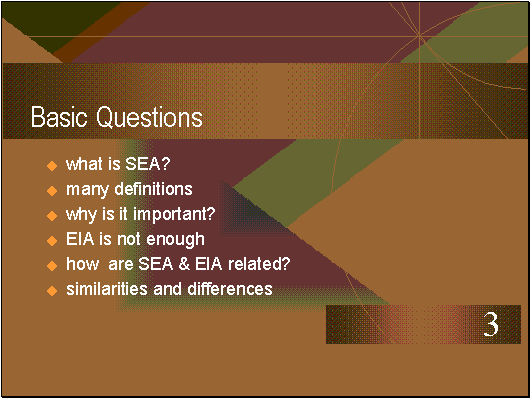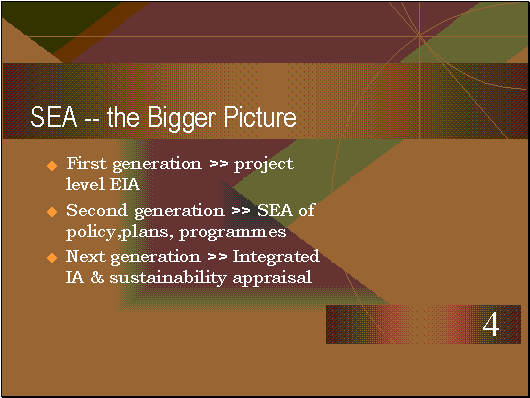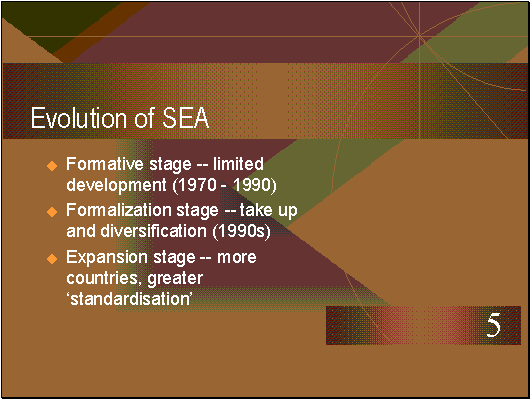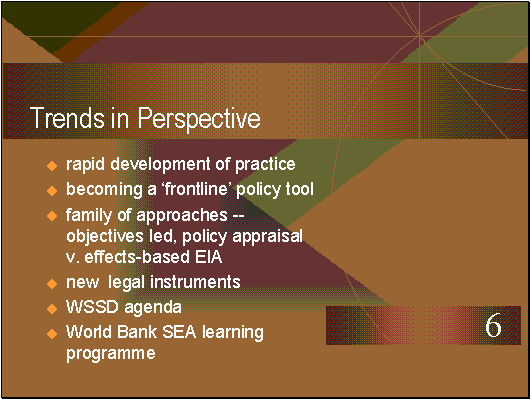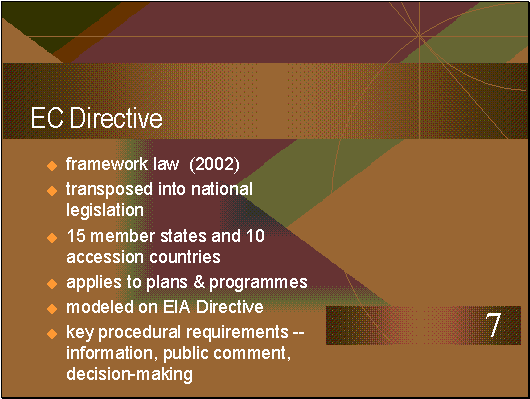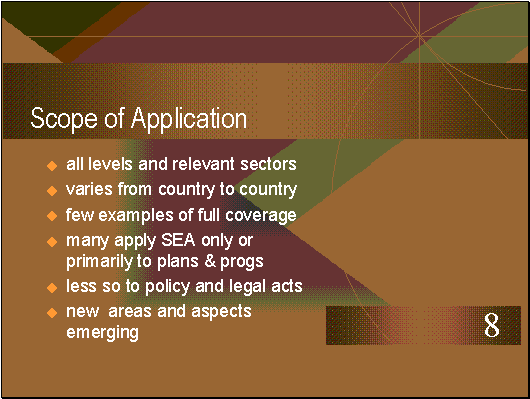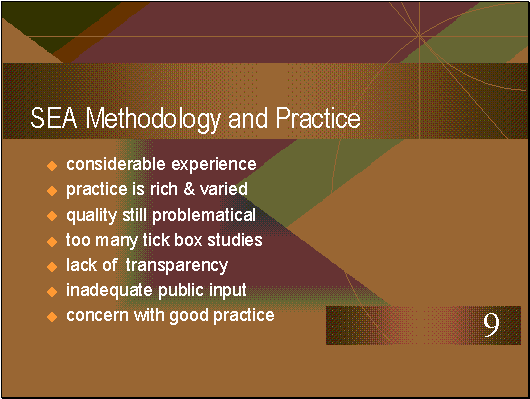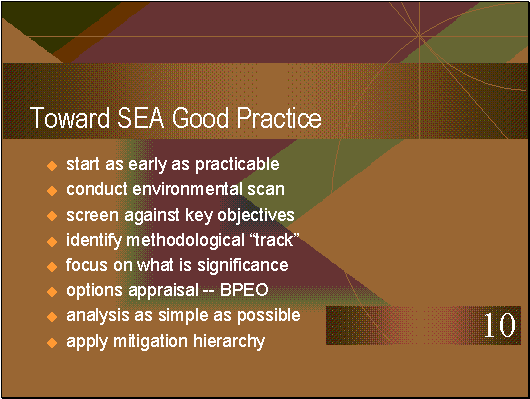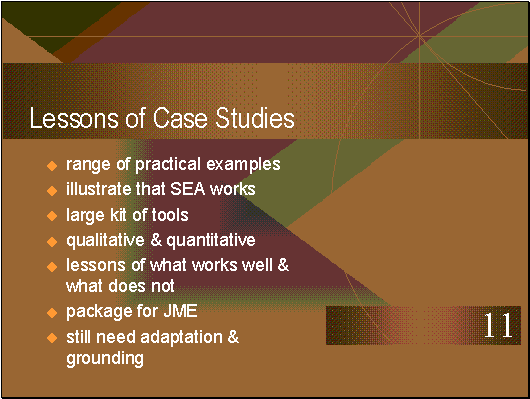|
[Slide1] Ladies and Gentlemen, good morning. My task is to give an overview of SEA trends, issues and prospects.
[Slide2] In outlining my presentation I would like to stress that this will set a broad framework and context drawing on international experience and provides if you will have the envelop within which some of the case studies that you will hear in detail later. The presentation is organized into four main parts. First I want to sketch a brief background by way of looking at some basic questions that are usually asked, for example, 'What is SEA?' Secondly, I would like to look into some of the major trends that have occurred in the development of this process over the past 20 years. Thirdly, I would like to take stalk of the current status of Strategic Environmental Assessment(SEA) as it's practice internationally and look at some of the key issues in the development of the field the kind of concerns and questions which are frequently asked and which also trouble practitioners of SEA. And fourthly, I'd like to look at the future prospect touching on perhaps where some of the case studies that you will hear later may take you in your own thinking in Japan about the development of SEA.
[Slide3] The first basic question: "What is SEA?" is frequently asked. There are many definitions, which tend to be variations on a theme. Essentially, SEA is a systematic process for evaluating the environmental effects of a proposed policy, plan or program or other type of broad strategic initiative. Why is that important? It's important because EIA on the project level on its own is not enough, as you've heard from our previous speaker. EIA projects tend to occur relatively late in the decision making process when all we can do is to mitigate some of the adverse impacts. SEA takes us up stream, up scale in the decision making process by addressing policies, plans and programs we are able to deal with the source of environmental problems not just treat the symptoms on their own. Third question, "How are EIA and SEA related?" There are similarities and differences, between the two processes. The similarities in SEA, we use EIA principles, and in many cases tend to draw on EIA methods and procedures in carrying out the practical aspects of work. But, we also use tools from other areas as well depending on the nature of the plan, program or policy. There are some differences; these are introduced largely because at the strategic level the issues that we are addressing tend to be less concrete and specific compared to project EIA. They are more general and have to take account of the fact that policy and plan making processes tend to work in a rather fluid way somewhat different from the linear systematic and structured approach that for example a project cycle will display. So these need to be bear in mind in looking at SEA compared to EIA.
[Slide4] Here I am trying to place SEA in the context of its evolution. I tend to see project level EIA for which we now have over 30 years of experience in some countries as a first generation process. Most countries in the world now operate EIA system, and this particular aspect is becoming well understood. The practice is soundly based and the lessons are widely disseminated. In the last ten years, we moved into what I would see as the second-generation process, and this is SEA at the level of policies, plans and programs. We really only have began to develop this process in the past 10 to 20 years in a way that compares to EIA. At the moment, as we'll see in the later slide, relatively small numbers of countries have operational SEA systems in place. We also appear to be and this is a very much an emerging trend that is not yet entirely clear. But we seem to be moving into a next generation process that is integrated impact assessment how we're able to consider the environmental the social and the economic impacts as part of one integrated process. Some also see this and call it sustainability appraisal: the attempt to identify whether a particular policy, plan, program or indeed project is environmentally, economically and socially sustainable. For that we need formal indicators and points of reference as to what is sustainable and what is not to be able to use integrated impact assessment as a true test whether a proposed action is likely to contribute to or to detract away from sustainability. I will perhaps comeback to that discussion in terms of future prospects.
[Slide5] In terms of the broad pattern of the evolution of SEA, we further move to three essential stages. The first is the formative stage between 1970 and 1990, which was characterized by limited development of SEA. Only the United States really had an actual formal SEA process in place and even that was limited largely to what was called programmatic environmental impact statements: only small fractions of the assessment done in the US applied at the programmatic level. Since 1990, we moved into the formalization stage where other countries have adopted and taken up SEA and the process itself has become much more diversified. At this moment, we have almost 15 different countries and a number of international agencies that actually have formal SEA systems in place. Many of them are applied as part of EIA law and procedure, but some are set up as entirely separate processes on a parallel path to the EIA itself. So there is one particular approach for institutionalizing SEA.
[Slide6] We'll come to the diversity a little more in a minute and I believe now were moving into what I called the expansion phase of SEA. Every indication is that far more countries will be taking up EIA and adopting it, and at the same time there will be a great standardization of the processes that applied. I come to the reasons for that on the next slide. So looking at the trends that we have now gathering the trends very broadly across the international arena. I think we can see first of all a rapid development of SEA practice. We have case examples as you will hear later. We understand a lot more about the methods and tools that work and to an extent those that do not. We know more about the limitations and the potentials of SEA than we did five years ago. So I think that the practice have internationally evolved significantly in the last five years. SEA is on its way on becoming what I call here a frontline policy tool in the sense of being able to delivery and help to promote more sustainable environmentally sustainable forms of development. Thirdly, SEA is not one single type of approach nor one single type of process rather it is a family of approaches. In some cases, we have what is called objectives-led SEA. This tends to be far more of process that is integrated with existing planning systems that identify the kind of example. If we take a new energy plan or a new energy policy for an SEA, that's objective-led to do a thorough appraisal of that. You will need to identify the environmental objectives that related to energy and use. Those are to try and appraise how this energy development will affect those objectives. You may use indicators you may use other kinds of rules of thumb or reference points to come to that decision. This is very much a policy appraisal type of tool rather than one that is drawn from environmental impact assessment itself. And we often tend to characterized SEA as either appraisal based or impact assessment-based. And some of those distinctions will become clearer to you. I hope during the course of some of the case studies that will be described to you over the next two or three hours. We also have a new set of legal instruments, international legal instruments that relate to SEA. The first of these that I will describe in more detail in the next slide is the European directive on SEA that applies throughout the European Union, and also to a number of accession countries, which are in the process of joining the European Union. We've also seen the completion of an SEA protocol to the UNECE convention on transboundary environmental impact assessment. So whether this EIA transboundary law has been in place internationally, now for over 10 years. We now have an SEA protocol that's been negotiated by some countries by as many as 50 European countries including many newly independent states of the former Soviet Union. Both of these developments are expected to spread the use of SEA far more widely than it has been to date. The next important point is the Johannesburg World Summit on sustainable development. The Johannesburg agenda has one of its main elements of the call or recommendation to delivery sustainable development to deliver the integrated approach to environment and development decision-making. We need analytical tools that are far more holistic, strategic and inter-sectoral taking into account. For example, when one sector is doing its planning and policy making not only the economic benefits but also the environmental and social impacts. So for those of you, who've read the plan of implementation that came from the Johannesburg Summit, throughout that document there's continued references to the need for this kind of approach. SEA itself is not explicitly mentioned but it very clearly understood to be one of the frontline tools for giving effect for that kind of wholistic intersectoral approach where the plan of implementation calls upon all countries to be pursuing far more vigorously than they have to date. Finally the World Bank, in the last three to five years has become for more active in terms of promoting strategic environmental assessment. It has its own requirements for borrowing countries regarding undertaking sectoral environmental assessments of major plans and programs that are part of its lending operation, as well as having a requirement for regional environmental assessment for taking into account the whole range of different activities that are to be located in a river basin. So the World Bank has become increasingly active both in its requirements and conditionality related to SEA and also in terms of the kind of capacity building and research work that it's done. The World Bank has what it calls an SEA learning program and I would recommend any of you who are interested in the tools, the techniques the lessons of SEA as they are applied by the bank in developing countries, to go to the bank website where you can quite easily find your way into the environment section and you will find reference to SEA learning program.
[Slide7] I mentioned in the previous slide International Legal instruments has been very important. I just want to spend a brief period of time on the European community directive on SEA; this is what is called a framework law. It sets out very general elements and procedural requirements. It was passed either end of May or beginning of June 2002. It is now process as required in European Union of being transposed into international legislation so each member state, the 15 member states of the European Union and the 10 accession countries, are all now transposing the framework law into their national legislation to give it operational force and this is to come into effect to be implemented by May 2004. So, in the very near future within the next two years to 18 months you can expect at least another given six European Union countries already have SEA. You can expect that at least another 20 will be taken it up through the requirements of the directive. The directive itself applies to plans and programs. It does not apply to policies. The policy was excluded deliberately and this was one of the very controversial aspects of the negotiation of the directive; this directive is negotiated by each of the member states and the process, depending on to whom you listen as it were, has taken at least 5 or as long as 7 years to actually negotiate through to a final law which was passed in 2002. Much of the controversial discussion was about whether policy should be included or not in effect the directive applies only to plans and programs. Although it is likely that in assessing plans and programs inevitably an SEA will take on some elements of evaluating policy. Mr. Verheem, one of his case studies, will talk about the national spatial plan for the West of the Netherlands where in fact the plan sets out in its first phase very broad policy directions, each of which were assess for them environmental effects, and only when the cabinet chooses one of those or a mixed of those will the planning go to the next more concrete phase where an SEA will be required informally under Dutch EIA law to assess the effect of the implementation of the particular plan. So even though policy is excluded from the European directive almost by definition of evaluating plans and programs for their environmental effects; you'll be looking at policy elements. The directive itself is very much modeled on the EIA directive. It has similar key procedural requirements, and it is expected that many of the methods and tools and approaches that are used in the EIA will be applied to SEA plans and programs. So some of the key procedural requirements that the directive requires relate to information; the type of information that needs to be placed in the environmental report. So that the directive has quite a section on information the contents of the report; it has specific requirements regarding public consultation and comment and it has particular procedural requirements regarding decision makers. For example, when a proposal has been subject to SEA, the decision maker must take account of the report and the public comments and give reasons for the decision which took note the fact that SEA does not obligate the decision maker to follow it nor to make any particular kind of decision. But it does obligate the decision maker to take into account the information and the public comments that were received. How they are dealt with is still within the discretion of the decision maker but the decision making authority must then also issue the reasons for the decisions made. So the intention here is to make the process more transparent and to a degree systematic than it has been in the past.
[Slide8] Looking at the scope of the application of SEA internationally, it covers all levels and relevant sectors. The actual scope of application varies from country to country. There are very few examples of any one country that has a fully comprehensive SEA system that would apply to policy to legislation and to plans and programs. Many countries apply SEA only or primarily to plans and programs and they apply SEA to a lesser degree to policy and legislation legal acts. There has in the past also been some difference in the institutional arrangements for undertaking SEA plans and programs compared to SEA plans and policies. In the early phase many countries or some countries: Canada, Denmark, Finland, the Netherlands as examples have set aside separate have identified separate processes for SEA policy and legislation that are based either on administrative order or on policy directive from the cabinet. So these processes initially and still are not a legal obligation rather they are requirements, policy requirements of the government that are put in place through administrative order. Part of the early thinking was that this was necessary for the kind of flexible approach that would be suitable and practical at the policy level. However there are some countries, Mr. Dusik may well talk about this. Czech Republic being one, Slovak Republic being another, that actually have legal requirements for a legal form for SEA which applies at the policy level. So the sense is that some countries that are quite in the past had centralized decision making systems and processes. Quite centralized ones may well be in the position to legislate for SEA policy as well as plans and programs but some of the other countries have preferred to retain this flexibility. So just leaving SEA at the policy level to a separate process that is administratively based and is not legally obligated. However these new areas and aspects are emerging all the time for SEA. One of the areas that is particularly intriguing and may commend itself to a Japanese audience is the application of SEA to trade agreements and trade liberalization. This is something that the United Nations Environment program is promoting at the moment. It is something, for example, that was applied to the North American free trade agreement by both Canada and the United States both of which did an SEA audit. And while in fact those SEAs did not necessarily affect the cost of trade negotiations themselves. What they did was the setting up of what is called a side or a flanking measure to take accounts of environmental effects which was the setting up of tri-countries environmental commission: the three countries being the US, Canada and Mexico all of which are partners in the trade negotiation so an example here of SEA being applied to quite a high level of political issue at the time. Certainly the trade agreement in Canada was quite controversial at the time it was negotiated with the US.
[Slide9] Let me turn now to SEA methodology and practice. Several points here these. We have considerable experiences internationally and collectively in the use of tools and methods for SEA. The practice itself and you will capture some of these in the presentations that follow. I think there's more than enough to learn from and to identify useful tips and insights in some cases. We do find that the quality of SEA practice is still problematic. We often have then this, which is both a Canadian and UK expression "too many tick box studies". There are too many studies where somebody has done an SEA from a simple checklist and ticked off all the boxes that say no discernable impact. For some cases the SEA process, until it matures a bit, can be a pro-form process. It can be a relatively routine paper exercise rather than a more systematic, analytical and structured approached that it's intended to be and I think for any country who is seriously interested in implementing SEA. This point has to be carefully watched. In some countries, there is a lack of transparency with SEA. In part that may be due to their particular constitutional conventions in Canada. For example, the SEA process is applied by government agencies as part of documentation for any proposal that goes before the federal cabinet and the federal cabinet in our system is the highest level of political authority. So the SEA process captures the decision making process to the very highest level. However, because of that cabinet has a convention of keeping all of its discussions and deliberations confidential. The SEA report itself is caught by that convention of cabinet confidentiality and therefore its not always transparent whether a process has been done properly and if a report has been filed what it actually says because all of these is caught by cabinet confidentiality. So some countries have, because of the constitutional situations, be lack of transparency too to them. In many cases, public input is inadequate, because SEA on one level is not something deals with issues that are not something the general public tends to become worried about. For example, if a power plant, a major project is to be built in a specific location that will normally attract concern and controversy and interest because people are being visibly and evidently affected. But if you are discussing an energy policy or plan in a general national level the general public normally may not be interested or want to get involved at the process at that level. And so one of the issues here is how to handle that. Because the environmental interest groups and others will certainly be interested in getting involved and that in a knob itself may or may not be a problem. So one of the difficulties we have to deal with is how to engage the public constructively in SEA at a general level. Whereby there's not the same interest as there would be for the specific projects in a particular locations. There's an increasing concern finally with SEA good practice. There's a lot of work going into these both through the international association for impact assessment and through various national guidance bodies such as the EIA commission for the Netherlands attempting to capture the principles the criteria of good practice and the lessons, which can be distilled from our experience to date.
[Slide11] I'm just going to comeback to this slide as my final one and I'll just now touch on some of the lessons broadly of the case studies that you will hear in a few minutes. The case studies as pooled together by the international team give a range of practical examples: from the transport field, from the special planning field, from the energy sector field, tourism development, a whole range of different practical examples. What they all illustrate in my mind in a general way is that SEA works as it can be used, it can be used to good effects and it can be used to add value to the decision making process. So for countries that are concern about environmental impact of major policy, planning and programming decisions, SEA can be used as it can add value and it can in many cases assist the planning process work better in terms of taking on board the full range of values that the plan of implementation from the Johannesburg Summit asked for. There's a large kit of tools, a large bag of tools, which can be used to undertake and carry out the technical aspects of SEA not all of them perhaps work as well as they might do at the very concrete project level and I'll explain the reasons for that in a few minutes. But they're available and they cannot be adapted to purpose. SEA undertakes both qualitative and quantitative assessment. This is something might really want to watch for as some of the case studies are discussed. Some will use quite sophisticated quantitative modeling traffic models. For example, air quality models to identify lightly impacts of a sector transportation strategy as an example others will be more qualitative assessment in part because the policy or plan maybe at such general level that it doesn't lend itself to quantitative tools. There is a number of lessons on what works well and what doesn't work well. And one of the things that the international team are trying to do with the assistance of Japanese colleagues is package these for the Japan Ministry of the Environment. In doing all of these of course as we'll probably hear in the panel discussion. Any process, any set of lessons, any procedures inherited from somewhere else needs adaptation to the particular decision making process as it works in your country or any other country. And it needs grounding by grounding. I mean it needs to be put into place in a very practical detail level in a way that it make sense to practitioners and possibly what makes sense to a practitioner in Canada may be different from the Netherlands and maybe different again from Japan. So part of the next step in the process as we see, it is for the Japanese team themselves to begin to think through how these tools can actually be used in a way that is useable for your purposes and adds value to the decision.
[Slide10] Let me finish by just pulling out several tips on SEA good practice all of which can be found in one way or another on the case studies. The first, I think a practical lesson start as early as practicable in the decision making process. So as soon as the policy is a concept and is becoming formulated or as soon as the intent of the plan is known or the program that is the time to start thinking of applying SEA, building environment into the thinking of the early stage. Sometimes helps to avoid problems at a later stage that may need to be mitigated by expensive practical measures. Conduct an environmental scan, of just what is out, what are the likely issues, and what are some of the environmental objectives and strategies that the government is already committed to that may be affected by this particular plan, program or policy. Screening the particular proposal ones, it got more definite stage against key objectives, key environmental objectives. The objectives, which the government is already or the Ministry of Environment is already committed to these, are in many different kinds of documents one of the tricks of this stage is to get out the relevant objectives that really matter to you. Identify the particular methodological track that will work. Rob Verheem and I in a previous piece of work came up with a very rough screening approach that identifies and asks a set of simple questions that identifies the kind of approach that will work best. So where you have a concrete plan, program or policy that fixes the location of something or has clear impacts somewhere, then impact assessment can be used. In some cases, the impacts may not be as direct as they are in the project level but nevertheless a cause and effect chain can be traced in some cases. The policy, plan or program may be too general and therefore it would become difficult to identify what precisely are the effects on the ground. And in that case a more policy appraisal type of approach, qualitative assessment, may be appropriate. Stay focus on what is really significant, in other words what are the likely effects and how will they damage the environment or have consequences or implications don't get caught in doing studies for the sake of doing studies. This is one of the risks of SEA that we'll identify in some kinds and some types of SEA systems, the people will excessively elaborate the methodology necessary to resolved a particular problem will compile too much paper work in terms of what likely the significant effects are. So its very important from an efficiency point of view and to put it bluntly from a selling point of view to other Ministries that SEA is used to focus on the things that matter and not just be another general; if you will have a study or report that covers everything in the same amount of detail, focus on what really matters, try and focus very much on considerations of alternatives on options appraisal on what we called here the BPEO, the Best Practical Environmental Option. By identifying that as early as possible major savings for the environment major benefits for the environment can be secured in terms of avoiding impacts. Make the analysis as simple as possible, in other words don't do more studies or used more sophisticated modeling that is necessary for the purpose of the problem that you're identifying and finally throughout the process apply the mitigation hierarchy, and by mitigation hierarchy I mean firstly the first priority is to avoid problems and sometimes by getting involved in the planning process early consideration of alternatives. We can avoid impacts by choosing the most environmentally friendly options or the least damaging options. Inevitably, there will be impacts. So the second priority is to try and minimize those, reduce them to as low as reasonably practical and we have a whole range of mitigation techniques depending on the particular issues that can be used and drawn from EIA. The third option, which is important to sustainability thinking the third element of the hierarchy is compensation, where there is residual damage significant residual damage to the environment that can not be avoided and can not be mitigated then there are grounds. If we are interested in sustainability for compensation and by compensation, I mean, in kind compensation, not necessarily monetary compensation. So if, for example, a major power plant is to be developed and it takes a valuable area of wetland but it must to be located on that wetland, then one of the things, therefore significant damage, that cannot be avoided or mitigated then, one of the things that is reasonable to ask under sustainability theory is for that to be compensated by the creation the reengineering of an equivalent amount of productive wetland elsewhere. In some cases, the trade off isn't like but if it were serious for example about the Kyoto protocol made here in Japan, there's very little at the moment or not a lot. We can do in terms of controlling the emission of CO2 about the smoke stalks. Pollution control technology in terms of carbon dioxide doesn't work that well. But if it were serious about compensation, then we would talk about carbon sequestering. And for so many thousand tons carbon dioxides pumped into the atmosphere. There is an equivalent amount that can be taken out over the long term through carbon sequestering. So one of the compensation options maybe is to grow a forested area that will deliver the equivalent of that carbon sequestering. Now we're not talking here in sustainability theory about the theory of the impossible. We are talking about practical action which we are committed to the WSSD the Johannesburg Agenda need to be made if we are generally serious about sustainability. So those are some of the things we've move away perhaps from the practical into moving back into the how SEA can help with moving towards sustainable development. But I believe that the mitigation hierarchy with its stood emphasis on compensation is one way of getting into that in a practical manner. So that's my presentation, ladies and gentlemen. I hope it's set a broad framework and context for the kinds of studies you will now hear. And I thank you for your attention. |
